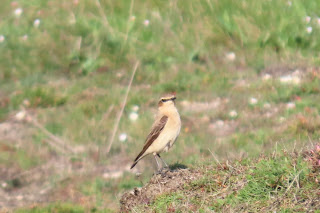After the excitement of yesterday I figured the fun was probably done, that that would be the best of it. But the wind forecast for this morning was roughly similar so I hoped there'd still be a few migrants to justify my 5.50 arrival, although it was a few degrees cooler than yesterday and there hadn't been the pre-dawn rain.
Early indications were that a few Willow Warblers had arrived, and I was pleased to have twenty in the notebook before getting to the scrubby heaven/hell of Hordle Cliff.
I was in for a shock! The bushes on the undercliff there were alive with them, with several also enjoying the sun on the cliff side itself.
I have no idea how many were lurking in the denser stuff, with very few birds vocal, but it seemed every one of the more isolated bushes had at least a couple, and birds chased each other round the willows and sallied for flies from almost every clump.
I counted fifty along this 1.2km stretch: that's just the ones I could see or hear. There could easily have been hundreds lurking unseen.
But the best was yet to come. Back at the Barton undercliff I decided to check the entire 2.1 length as far west as I could go, always from the clifftop. Along here, where it's mostly more open and viewing more clear, I counted a further NINETY!!! In all today I had at least 160 along 4.7km of coast, almost all on the undercliff. I've never had a fall like it at Barton, and chances are I never will again. Aside from some of my better autumn vismig days, I've never had a birding spectacle like it there.
And there was other stuff too. Two Garden Warblers, a Sedge Warbler and a Reed Warbler evaded the camera (the latter two were patch year ticks), but one of the two Redstarts (until yesterday I'd not had a spring one on patch) allowed a photo of sorts
What was presumably yesterday's Whinchat remained
Two late Lapwings flew northeast
There were Wheatears of course (four of them)
And Whimbrels, mostly passing through, but also one hanging about on the cliff top.
Seven Yellow Wagtails came in off; 4 Gannets and 13 Common Scoter flew east offshore, although I didn't look that way as much as usual: I was just mesmerised by the little greeny yellow birds that had miraculously arrived en masse from halfway down an entirely different continent, having crossed a vast desert and two not insignificant seas.
Really blows the mind, and it was a total privilege to be a part of it.






































